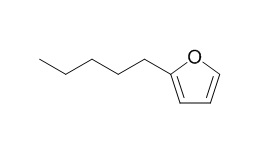2-Pentylfuran
2-Pentylfuran is a naturally occuring flavouring ingredient, it may be a biomarker for lung colonization/infection by fungal pathogens. 2-Pentylfuran and isomers of 2-pentenylfuran are known to be mainly responsible for the undesirable reversion flavor of soybean oil.
Inquire / Order:
manager@chemfaces.com
Technical Inquiries:
service@chemfaces.com
Tel:
+86-27-84237783
Fax:
+86-27-84254680
Address:
1 Building, No. 83, CheCheng Rd., Wuhan Economic and Technological Development Zone, Wuhan, Hubei 430056, PRC
Providing storage is as stated on the product vial and the vial is kept tightly sealed, the product can be stored for up to
24 months(2-8C).
Wherever possible, you should prepare and use solutions on the same day. However, if you need to make up stock solutions in advance, we recommend that you store the solution as aliquots in tightly sealed vials at -20C. Generally, these will be useable for up to two weeks. Before use, and prior to opening the vial we recommend that you allow your product to equilibrate to room temperature for at least 1 hour.
Need more advice on solubility, usage and handling? Please email to: service@chemfaces.com
The packaging of the product may have turned upside down during transportation, resulting in the natural compounds adhering to the neck or cap of the vial. take the vial out of its packaging and gently shake to let the compounds fall to the bottom of the vial. for liquid products, centrifuge at 200-500 RPM to gather the liquid at the bottom of the vial. try to avoid loss or contamination during handling.
JPC-Journal of Planar Chromatography 2017, 30(2)
J Nat Sc Biol Med2019, 10(2):149-156
Redox Rep.2024, 29(1):2392329.
Br J Pharmacol.2020, 10.1111
Oxid Med Cell Longev.2022, 2022:5888636.
Planta Med.2022, 88(9-10):794-804.
Molecules. 2013, 18(11):14105-21
J Korean Society of Food Science & Nutrition2021, 50(9): 962-970
BMC Complement Altern Med.2014, 14:242
Revista Brasileira de Farmacognosia2024, 34:1091-1100.
Related and Featured Products
Med Mycol. 2008 May;46(3):209-15.
Investigation into the production of 2-Pentylfuran by Aspergillus fumigatus and other respiratory pathogens in vitro and human breath samples.[Pubmed:
18404548 ]
Our objective was to identify, for diagnostic purposes, potential volatile biomarkers of human microbial pathogens.
METHODS AND RESULTS:
We analysed the head space of cultures of medically important bacterial and fungal respiratory pathogens for 2-Pentylfuran (2PF) production through the use of Solid Phase Micro Extraction (SPME) and Gas Chromatography/Mass Spectroscopy (GC/MS). Our results confirm that 2PF is consistently produced by Aspergillus fumigatus, Fusarium spp., Aspergillus terreus, Aspergillus flavus and to a lesser extent by Aspergillus niger. 2-Pentylfuran was not detected from most of the bacterial strains except for Streptococcus pneumoniae. In human studies, four litre breath samples were collected from patients with cystic fibrosis (CF), with and without colonisation by A. fumigatus and other pathogens, as well as healthy volunteers. 2-Pentylfuran was detected in breath samples collected from 4/4 patients with CF and A. fumigatus colonization, 3/7 patients with CF and no microbiological evidence of A. fumigatus and 0/10 healthy control individuals.
CONCLUSIONS:
These results suggest that 2PF may be a biomarker for lung colonization/infection by fungal pathogens. To our knowledge, this is the first report describing the detection in breath samples of a volatile biomarker of a pathogen resident in the lungs. Breath analysis has the potential of being a non-invasive diagnostic method of detecting respiratory infection including invasive aspergillosis.
Journal of Food Science, 2003 , 68 (4) :1175-8.
Singlet Oxygen Oxidation for 2-Pentylfuran and 2-Pentenyfuran Formation in Soybean Oil[Reference:
WebLink]
2-Pentylfuran and isomers of 2-pentenylfuran are known to be mainly responsible for the undesirable reversion flavor of soybean oil.
METHODS AND RESULTS:
Solid-phase microextraction - gas chromatography - mass spectrometry was used to isolate, separate, and identify 2-Pentylfuran and isomers of 2-pentenylfuran from soybean oil containing 5 ppm chlorophyll in a gas-tight sample bottle during oxidation under light. Both 2-Pentylfuran and isomers of 2-pentenylfuran increase as light exposure time and added chlorophyll increased. The compounds were neither formed in the oil containing 5 ppm chlorophyll under dark nor in the chlorophyll-free soybean oil under light.
CONCLUSIONS:
The singlet oxygen oxidation mechanism for the formation of 2-Pentylfuran from linoleic acid and isomers of 2-pentenylfuran from linolenic acid are proposed. Removal of chlorophyll will reduce reversion flavor formation.



